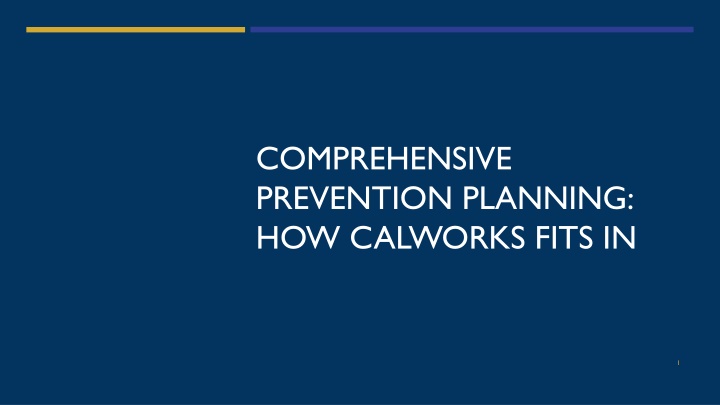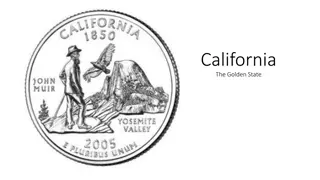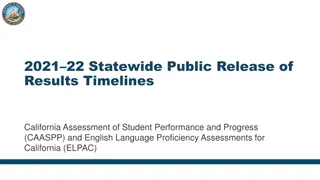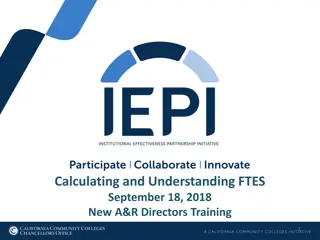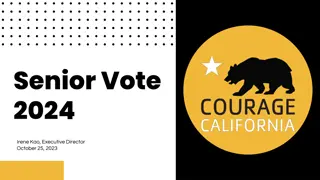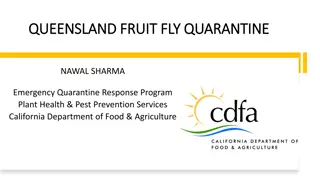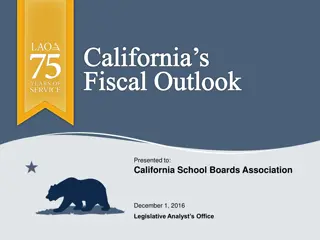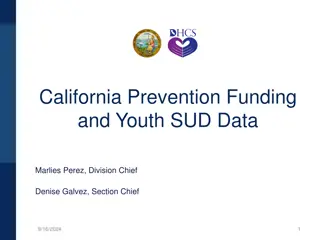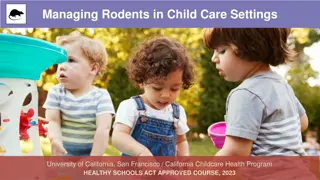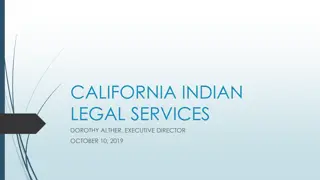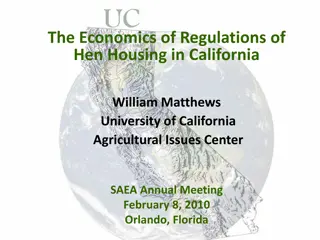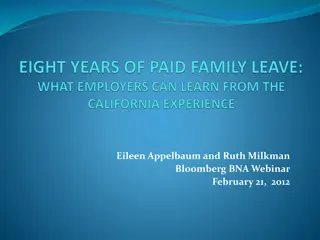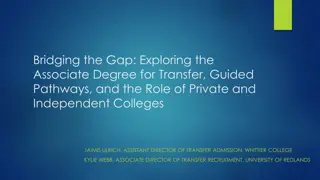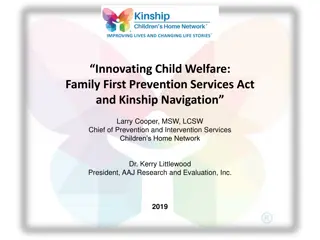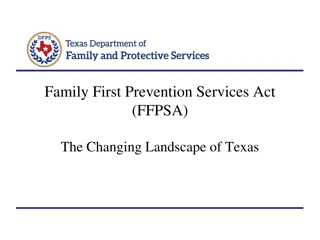California's Family First Prevention Services Program
California's Family First Prevention Services Program, established under the Family First Prevention Services Act of 2018, aims to provide evidence-based prevention and trauma-informed services to children and youth at risk of entering foster care. The program leverages a comprehensive plan that includes culturally appropriate services and emphasizes cross-sector collaboration. By focusing on prevention and early intervention, the program aims to support families and reduce entries into out-of-home care.
Download Presentation

Please find below an Image/Link to download the presentation.
The content on the website is provided AS IS for your information and personal use only. It may not be sold, licensed, or shared on other websites without obtaining consent from the author.If you encounter any issues during the download, it is possible that the publisher has removed the file from their server.
You are allowed to download the files provided on this website for personal or commercial use, subject to the condition that they are used lawfully. All files are the property of their respective owners.
The content on the website is provided AS IS for your information and personal use only. It may not be sold, licensed, or shared on other websites without obtaining consent from the author.
E N D
Presentation Transcript
COMPREHENSIVE PREVENTION PLANNING: HOW CALWORKS FITS IN 1
AGENDA Family First Prevention Services Act (FFPSA) What is a Comprehensive Prevention Plan and why is it important? Cross-Sector collaboration Intersection between CalWORKS and child welfare What is the intersection between CalWORKS and the Comprehensive Prevention Plan? How to get involved locally Local story from Orange County 2
VISION FOR CALIFORNIA An integrated state-wide system that supports families to provide safe, stable, nurturing relationships and environments for their children. To achieve the vision silos must be broken and partnerships across multi-disciplinary sectors must be built 3
SHIFTING THE MINDSET Shifting the mindset from a reactive approach to a proactive approach From services to improving the conditions in which we live, grow, play (SDOH) From prevention to well-being Equity and community engagement Lifting the voice of those with lived expertise 4
Prevention Framework 5
FAMILY FIRST PREVENTION SERVICES ACT (FFPSA) PART 1 OF 2018 The Family First Prevention Services Act (FFPSA) was passed and signed into law (P.L. 115-123) as part of the Bipartisan Budget Act on February 9, 2018. New option for States and Tribes to claim Title IV-E entitlement funds for evidence-based prevention and trauma- informed services for children and youth who are deemed candidates (at imminent risk for entry into foster care) Evidence-based interventions funded by Title IV-E must be selected from the Title IV-E Prevention Clearinghouse, fall within one of the following categories, and be included in California s Five-Year State Prevention Plan In-home parent skill-based programs Mental health services,and Substance abuse prevention and treatment services The legislation is intended to reduce entries into care by funding prevention services and interventions to mitigate imminent-risk factors and maintain a child and youth s placement in-home 6
CALIFORNIA'S FAMILY FIRST PREVENTION SERVICES PROGRAM (FFPS) Leverages current prevention efforts to reach a broader audience and reach families sooner Built from a comprehensive plan that includes culturally appropriate and responsive services that are tailored to meet the needs of local families who are disproportionately represented in the child welfare system Rooted in a cross-sector collaborative approach Meets the federal requirements of FFPSA Part 1 and goes beyond to deliver services across the prevention continuum Access to a Community Pathway approach to service delivery for early community-based services 7
CALIFORNIA'S FAMILY FIRST PREVENTION SERVICES PROGRAM (FFPS) Family First Prevention Services Act Five - Year Prevention Plan FFPS State Block Grant Assembly Bill 153 Family First Prevention Services Program 8
FFPS PROGRAM AND THE COMPREHENSIVE PREVENTION PLAN Family First Prevention Services (FFPS) Program In accordance with WIC 16588, a local title IV-E agency opting into the FFPS Program is required to submit a Comprehensive Prevention Plan (CPP). WIC 16588 Comprehensive Prevention Plan Tertiary Prevention Strategies (must encompass FFPSA Part 1) Primary Prevention Strategies Secondary Prevention Strategies 9
WHAT ARE THE COMPREHENSIVE PLAN COMPONENTS? Asset Mapping and Needs Assessment Candidacy Population and Services Theory of Change/Logic Model Cross-Sector Collaboration Governance Structure Workforce Training and Development Continuous Quality Improvement Tribal Model Fidelity of EBPs Child Safety Monitoring Engagement Coordination with local Mental Health Plans Integrated Core Practice Model Spending Plan Sustainability Assurances 10
CAPC Director Child Welfare Director Tribal Leadership Parent Leaders Office of Education Cross-Sector Collaboration Economic Assistance Regional Center Behavioral Health/Mental Health Non-Profit Agencies Public Health District Attorney 11 Probation
CROSS-SECTOR PARTNERS Recommended Partners Family Resource Centers (FRC) Private Organizations Evidence-Based Program Provider/Purveyor Expert Program Evaluator Faith-Based Institutions First 5 Public Health Department Public Assistance Department District Attorney s Office Early Childhood Programs Housing Department/Authority Pediatricians who are screening for ACEs Courts/judges especially juvenile Tribal Social Service Agencies Required Partners Child Abuse Prevention Council (CAPC) Chair or Coordinator Child Welfare Agency Probation Department Tribal Representation Office of Education Behavioral/Mental Health Department Non-Profit/Community-Based Organizations (including Family Resource Centers) Youth Leader (Lived Expertise) Parent Leader (Lived Expertise) 12
EXAMPLES OF ACTIVITIES INCLUDED IN THE CPP Primary, Secondary and Tertiary Prevention Any primary and secondary service that meets local needs Emphasis on services that meet the culturally diverse needs of the community Evidence-based practices and programs not included in the CA Prevention Plan Services tailored to meet the needs of families who are disproportionately represented in the child welfare system, including Native American and Alaskan Native families, families of color, and LGBTQ+ Locally determined through collaborative planning and implementation process Population Served 13 As determined in the local CPP based on the needs of the community
ROLE OF CALWORKS/LINKAGES IN THE CPP CROSS-SECTOR COLLABORATIVE Inclusion of Data to determine Target Population/Candidacy Population and Services Asset Mapping Needs Assessment Gap Analysis Primary, Secondary, Tertiary Prevention Inclusion of Linkages services (i.e. Welfare to Work, Family Stabilization, CalWORKs Home Visiting) Development of Policies and Procedures Coordinated case planning Leveraging of existing MOUs Evaluation & Continuous Quality Improvement (CQI) Leveraging funds for sustainability of programs & services 17
OPT IN COUNTIES 50 Counties Amador Butte Contra Costa Alameda Calaveras Colusa Del Norte El Dorado Fresno Glen Humboldt Kern Kings Lake Lassen Los Angeles Madera Marin Mariposa Mendocino Merced San Mono Napa Nevada Orange Placer Riverside Sacramento San Benito Bernardino San Luis Obispo San Diego San San Joaquin Santa Barbara Santa Cruz Shasta Sierra San Mateo Santa Clara Francisco Siskiyou Solano Stanislaus Sutter Tulare Tuolumne Ventura Yolo Yuba Sonoma
HOW DO YOU SEE YOUR LINKAGES PROGRAM FITTING INTO COMPREHENSIVE PREVENTION PLANNING? Poll: Is Linkages included in your Comprehensive Prevention Planning now? (Yes, No, Unsure?) Will you bring it to your Comprehensive Prevention Planning Team? (Yes, No, Unsure?) 20
A LOCAL STORY FROM ORANGE COUNTY Rita Rangel, MSW from Orange County Social Services Agency- Children and Family Services 21
CONTACT INFORMATION Contact for FFPSA Prevention Services (Part I) and Comprehensive Prevention Plan questions: ffpsapreventionservices@dss.ca.gov For additional information,please access the FFPSA website: cdss.ca.gov/inforesources/ffpsa 22
